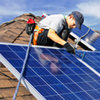One of the most interesting and exciting trends in modern construction is the implementation of passive energy design in the construction of all kinds of buildings, including residential, commercial, governmental, and other structures. From a new massive housing project in Canada to an off-the-grid “Solar Earthship” in rural Colorado, passive home design is quickly becoming the go-to concept for architects and builders throughout North America, and indeed the world.
Introducing Passive Home Design
 First, let’s take a closer look at what passive home design really involves. The core of a passive home design is solar energy. In the case of structures that are built from the ground up, the design of the structure is inherently and intentionally planned to reduce the heating and cooling loads that the building must carry, and then meet those needs either in whole or in part with energy derived from solar panels. Homes can also often be remodeled to take advantage of passive energy benefits, starting with a home energy audit to identify the most logical improvements.
First, let’s take a closer look at what passive home design really involves. The core of a passive home design is solar energy. In the case of structures that are built from the ground up, the design of the structure is inherently and intentionally planned to reduce the heating and cooling loads that the building must carry, and then meet those needs either in whole or in part with energy derived from solar panels. Homes can also often be remodeled to take advantage of passive energy benefits, starting with a home energy audit to identify the most logical improvements.
Choosing the Right Build Site
Because of the unique nature of solar energy, the positioning of a passive structure is critical. Most importantly, the south side of the structure needs to have unobstructed access to the sun. Obstructions can also be generated over time, as new buildings are built in a neighborhood or community, or small trees grow into big trees. The windows that collect solar energy need access to the sun during the majority of daylight hours during the heating season, and should be shaded during cooling seasons to prevent overheating the home.
 Essentially, passive home design works because the home or building collects heat as the sun shines through the south-facing windows and retains it in building materials that store heat, known to designers as thermal mass. The materials that serve as a passive home’s thermal mass often include common building materials such as concrete, brick, stone, and tile, but can also include more unusual materials such as water. This heat is then distributed to different areas via different methods, including conduction, convection, and radiation.
Essentially, passive home design works because the home or building collects heat as the sun shines through the south-facing windows and retains it in building materials that store heat, known to designers as thermal mass. The materials that serve as a passive home’s thermal mass often include common building materials such as concrete, brick, stone, and tile, but can also include more unusual materials such as water. This heat is then distributed to different areas via different methods, including conduction, convection, and radiation.
Passive House Principles
 It’s important to understand the fundamental principles behind passive home design before embarking on a project. The Passive House Alliance U.S. is a good place to start both to delve deeper into passive home design and to help identify architects, designers, engineers, and construction professionals who understand and have experience with this unique concept.
It’s important to understand the fundamental principles behind passive home design before embarking on a project. The Passive House Alliance U.S. is a good place to start both to delve deeper into passive home design and to help identify architects, designers, engineers, and construction professionals who understand and have experience with this unique concept.
Getting to the level of energy efficiency exercised by passive home design can be a challenge. Maximizing gains in energy while minimizing the loss of energy isn’t necessarily a natural function of most homes. To that end, passive energy projects utilize very specific principles of design, including:
- installing high-tech insulation throughout the entirety of the home;
- making the building envelope airtight. Because the home is sealed most of the time, condensation and mold risks are reduced, but passive home owners can still open their doors and windows just as they would in a “traditional” home;
- employing high-performance windows with low emissivity window glazing to minimize energy loss and maximize energy gain;
- installing smart distribution mechanisms to collect and store solar energy, which may include items like sun-heated floors, heat transfer via air or water, and the use of different color palettes to absorb or reflect heat at different places in the home; and,
- maximizing solar energy during the heating season and minimizing heat gain during the cooling season.
Examples of Smart Passive Energy Buildings
As builders continue to embrace passive energy design and net zero concepts, the number of passive design builds in North America and Europe continue to diversify.
In recent years, Canada has joined the Smart City movement in the goal of eliminating greenhouse gas emissions by 2030. To that end, a massive passive home project is underway in Vancouver, with the goal of creating a six-story mixed-use building that combines street-level retail with 85 units of rental housing.
The project is called The Heights, and when complete will be one of the largest passive energy projects in North America, and the largest in Canada. The project uses a simple single envelope design to retain and distribute heat, meaning that each unit can be heated using a simple electric baseboard heater running on just 300 watts.
 Another interesting passive home project is nestled in the San Juan Mountains in southeastern Colorado, where the so-called “Solar Earthship,” is not only energy efficient but net positive, meaning it creates its own energy. In addition to implementing the passive energy principles detailed above, the home’s walls are nearly 100% thermal mass, having been constructed from 2,000 recycled tires packed with dirt, then covered with adobe.
Another interesting passive home project is nestled in the San Juan Mountains in southeastern Colorado, where the so-called “Solar Earthship,” is not only energy efficient but net positive, meaning it creates its own energy. In addition to implementing the passive energy principles detailed above, the home’s walls are nearly 100% thermal mass, having been constructed from 2,000 recycled tires packed with dirt, then covered with adobe.
Some inspired homeowners sometimes even retrofit their homes to fit the passive energy home design concept. From Quonset huts to antique farm homes, almost any structure can be assessed, reconfigured, and redesigned to take advantage of solar energy and passive home ideas, although introducing recycled materials into an existing structure may take more time and cost. Passive energy design has also been utilized in all kinds of non-residential structures including schools, office buildings, and even public swimming pools in order to better capture and utilize solar energy.
The Benefits of Passive Energy Design
 Passive energy buildings offer their occupants tremendous short-term and long-term benefits, not only in cost but also in comfort. Passive homes in general cost five to 10 percent more to build than traditional homes, but the long-term savings in energy costs more than offsets that investment. It’s worth keeping in mind that federal, state, or community tax credits or other tangible benefits may apply to your passive home project.
Passive energy buildings offer their occupants tremendous short-term and long-term benefits, not only in cost but also in comfort. Passive homes in general cost five to 10 percent more to build than traditional homes, but the long-term savings in energy costs more than offsets that investment. It’s worth keeping in mind that federal, state, or community tax credits or other tangible benefits may apply to your passive home project.
Regardless, the incredible efficiency of passive home design provides homeowners and occupants with unmatched comfort, excellent indoor air quality, extremely resilient construction, and the best opportunity to reach net zero and net positive energy standards.
 This is a blog about saving energy, so we would be remiss if we failed to explain how a wall of plants, well, saves you energy! According to the folks at Ambius, “Unlike brick or concrete, plant surfaces don’t store up solar energy, but reflect it. Both interior and exterior walls help to actively cool the air in summer by a process called evapotranspiration, reducing the need to cool the building. (A living wall) will insulate the building and reduce energy costs for heating the building in winter as well.”
This is a blog about saving energy, so we would be remiss if we failed to explain how a wall of plants, well, saves you energy! According to the folks at Ambius, “Unlike brick or concrete, plant surfaces don’t store up solar energy, but reflect it. Both interior and exterior walls help to actively cool the air in summer by a process called evapotranspiration, reducing the need to cool the building. (A living wall) will insulate the building and reduce energy costs for heating the building in winter as well.” Some plants require more management than others. A croton, for example, requires half a dozen hours of sunlight and near constant watering in order to survive. If you know your lifestyle or gardening skills won’t be commensurate with the amount of time it takes to keep a finicky plant alive, plan realistically. There’s nothing wrong with a living wall of succulents.
Some plants require more management than others. A croton, for example, requires half a dozen hours of sunlight and near constant watering in order to survive. If you know your lifestyle or gardening skills won’t be commensurate with the amount of time it takes to keep a finicky plant alive, plan realistically. There’s nothing wrong with a living wall of succulents. Like many energy saving measures, living walls are an investment. Know how much you are willing to pay up front—according to Housetrends, living walls run around $90-130 per square foot for installation and irrigation. And know how long you plan to live in your dwelling so you can make the investment worth it. If you can swing it, now might be the perfect time to make your walls come alive.
Like many energy saving measures, living walls are an investment. Know how much you are willing to pay up front—according to Housetrends, living walls run around $90-130 per square foot for installation and irrigation. And know how long you plan to live in your dwelling so you can make the investment worth it. If you can swing it, now might be the perfect time to make your walls come alive.

 Our friends at Green Builder Media
Our friends at Green Builder Media  The second big strength of The Flex House is implied by its name. Single? You can create hundreds of square feet of recreation/office space. Looking to raise kids in your Flex House? Any number of floor plans can help you optimize your family’s sanctuary. You can have upstairs space or you can keep things on one story. You can add expansion modules or keep the floor plan basic. Remarkably, a home that can be “100 percent energy self-sufficient” per Green Builder is also virtually as adaptable as any you’re likely to find.
The second big strength of The Flex House is implied by its name. Single? You can create hundreds of square feet of recreation/office space. Looking to raise kids in your Flex House? Any number of floor plans can help you optimize your family’s sanctuary. You can have upstairs space or you can keep things on one story. You can add expansion modules or keep the floor plan basic. Remarkably, a home that can be “100 percent energy self-sufficient” per Green Builder is also virtually as adaptable as any you’re likely to find. Here’s where this all starts to get ridiculous. The sizable, adaptable Flex House is not some sort of boutique home design. Amazingly, the base model will cost between $85,000 and $100,000, about the median home price in
Here’s where this all starts to get ridiculous. The sizable, adaptable Flex House is not some sort of boutique home design. Amazingly, the base model will cost between $85,000 and $100,000, about the median home price in  First, let’s take a closer look at what passive home design really involves. The core of a passive home design is solar energy. In the case of structures that are built from the ground up, the design of the structure is inherently and intentionally planned to reduce the heating and cooling loads that the building must carry, and then meet those needs either in whole or in part with energy derived from solar panels. Homes can also often be remodeled to take advantage of passive energy benefits, starting with a
First, let’s take a closer look at what passive home design really involves. The core of a passive home design is solar energy. In the case of structures that are built from the ground up, the design of the structure is inherently and intentionally planned to reduce the heating and cooling loads that the building must carry, and then meet those needs either in whole or in part with energy derived from solar panels. Homes can also often be remodeled to take advantage of passive energy benefits, starting with a  Essentially, passive home design works because the home or building collects heat as the sun shines through the south-facing windows and retains it in building materials that store heat, known to designers as thermal mass. The materials that serve as a passive home’s thermal mass often include common building materials such as concrete, brick, stone, and tile, but can also include more unusual materials such as water. This heat is then distributed to different areas via different methods, including conduction, convection, and radiation.
Essentially, passive home design works because the home or building collects heat as the sun shines through the south-facing windows and retains it in building materials that store heat, known to designers as thermal mass. The materials that serve as a passive home’s thermal mass often include common building materials such as concrete, brick, stone, and tile, but can also include more unusual materials such as water. This heat is then distributed to different areas via different methods, including conduction, convection, and radiation. It’s important to understand the fundamental principles behind passive home design before embarking on a project.
It’s important to understand the fundamental principles behind passive home design before embarking on a project.  Another interesting passive home project is nestled in the San Juan Mountains in southeastern Colorado, where the so-called
Another interesting passive home project is nestled in the San Juan Mountains in southeastern Colorado, where the so-called  Passive energy buildings offer their occupants tremendous short-term and long-term benefits, not only in cost but also in comfort. Passive homes in general cost five to 10 percent more to build than traditional homes, but the long-term savings in energy costs more than offsets that investment. It’s worth keeping in mind that federal, state, or community tax credits or other tangible benefits may apply to your passive home project.
Passive energy buildings offer their occupants tremendous short-term and long-term benefits, not only in cost but also in comfort. Passive homes in general cost five to 10 percent more to build than traditional homes, but the long-term savings in energy costs more than offsets that investment. It’s worth keeping in mind that federal, state, or community tax credits or other tangible benefits may apply to your passive home project.